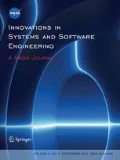Abstract
Use cases and user interface prototypes are agile techniques used to specify required functionalities of an object-oriented system. Testing can find most errors of the software and ensure that the requirement specifications are satisfied by the application. We can derive test cases from use cases and run them in user interfaces, but we do it in a mechanical way. In this paper, we propose a new approach for automating the generation of user interface prototypes and test cases for web applications. Starting from a formalization of the requirements based on controlled use cases extended with the system glossary and the user interface specifications, we automatically generate web pages and test cases which are passed as parameters for an automated web testing tool.
Similar content being viewed by others
References
Beck K, Andres C (2004) Extreme programming explained: embrace change. Addison-Wesley, Reading
Astels D (2003) Test-driven development: a practical guide. Prentice Hall, Upper Saddle River
Jacobson I (1992) Object-oriented software engineering: a use case driven approach, 1 edn. Addison-Wesley, Reading
Carroll JM (1999) Five reasons for scenario-based design. In: 32nd Hawaii international conference on system sciences
Myers J (1979) The art of software testing. Wiley, New York
World Wide Web Consortium. Extensible markup language. http://www.w3.org/XML/. Accessed 20 Nov 2009
Xiaochun Z, Bo Z, Juefeng L, Qui G (2008) A test automation solution on gui functional test. In: The IEEE international conference on industrial informatics
Huang C, Chen HY (2008) A tool to support automated testing for web application scenario. In: The IEEE international conference on systems, man and cybernetics
Jacobson I, Booch G, Rumbaugh J (2005) The unified modeling language user guide. Addison-Wesley, Reading
Li L, Miao H (2008) An approach to modeling and testing web applications based on use cases. In: 2008 International symposium on information science and engineering
Beck K et al (2009) Agile manifesto. http://www.agilemanifesto.org/. Accessed 20 Nov 2009
Open QA (2009) Selenium framework. http://www.seleniumhq.org/. Accessed 20 Nov 2009
Elkoutbi M, Khriss I, Keller RK (2006) Automated prototyping of user interfaces based on uml scenarios. Automated Software Engineering
Olek L, Michalik B, Nawrocki J, Ochodek M (2007) Quick prototyping of web applications. Balancing Agility and Formalism in Software Engineering
Parr T et al (2009) Antlr—another tool for language recognition. http://www.antlr.org/. Accessed 20 Nov 2009
Schwitter R (2002) English as a formal specification language. In: 13th International workshop on database and expert system applications
Author information
Authors and Affiliations
Corresponding author
Rights and permissions
About this article
Cite this article
de Matos, E.C.B., Sousa, T.C. From formal requirements to automated web testing and prototyping. Innovations Syst Softw Eng 6, 163–169 (2010). https://doi.org/10.1007/s11334-009-0112-5
Received:
Accepted:
Published:
Issue Date:
DOI: https://doi.org/10.1007/s11334-009-0112-5




